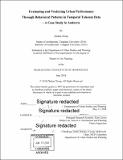| dc.contributor.advisor | Kent Larson. | en_US |
| dc.contributor.author | Xiong, Zhekun | en_US |
| dc.contributor.other | Massachusetts Institute of Technology. Department of Urban Studies and Planning. | en_US |
| dc.date.accessioned | 2018-09-17T15:56:21Z | |
| dc.date.available | 2018-09-17T15:56:21Z | |
| dc.date.copyright | 2018 | en_US |
| dc.date.issued | 2018 | en_US |
| dc.identifier.uri | http://hdl.handle.net/1721.1/118074 | |
| dc.description | Thesis: M.C.P., Massachusetts Institute of Technology, Department of Urban Studies and Planning, 2018. | en_US |
| dc.description | Cataloged from PDF version of thesis. | en_US |
| dc.description | Includes bibliographical references (pages 76-83). | en_US |
| dc.description.abstract | Evaluating and predicting performance of urban space has always set a challenge for the design and planning community. The lack of tools and data that can shed a light on how human flow is affected by urban spaces left many design decisions unexplained or unproven. However, with the constant emergence of advanced spatial-temporal analysis methods and availability of massive datasets, researchers can now better expose human behavioral patterns within dense urban settings. Focusing on the case study area of Andorra, this research experiments in analyzing Radio Network Controller (RNC) records of cell phone, which is of higher accuracy and precision, and uses computational data science algorithms such as Stay Point Detection algorithm and Density-Based Spatial Clustering of Application with Noise (DBSCAN) to evaluate performance of urban space. By leveraging regression models for machine learning, the research attempts to match characteristics of human behavioral patterns of clustering including persistence, size and diversity, with discrete urban features such as urban function, transportation network, natural landscape, and built environment. In this way, the research aims to find evidence-based correlations between urban performance and the design of urban form. On one hand, the results provide statistical analysis for potential opportunities to improve urban performance in Andorra particularly, and guidance in practice for urban planning and urban design field. On the other hand, this research explores a novel method to analyze diverse behavioral patterns in large urban populations, and to associate them with discrete urban features, which can potentially be applied to urban spaces in similar scale. | en_US |
| dc.description.statementofresponsibility | by Zhekun Xiong. | en_US |
| dc.format.extent | 83 pages | en_US |
| dc.language.iso | eng | en_US |
| dc.publisher | Massachusetts Institute of Technology | en_US |
| dc.rights | MIT theses are protected by copyright. They may be viewed, downloaded, or printed from this source but further reproduction or distribution in any format is prohibited without written permission. | en_US |
| dc.rights.uri | http://dspace.mit.edu/handle/1721.1/7582 | en_US |
| dc.subject | Urban Studies and Planning. | en_US |
| dc.title | Evaluating and predicting urban performance through behavioral patterns in temporal telecom data : a case study in Andorra | en_US |
| dc.type | Thesis | en_US |
| dc.description.degree | M.C.P. | en_US |
| dc.contributor.department | Massachusetts Institute of Technology. Department of Urban Studies and Planning | |
| dc.identifier.oclc | 1051772890 | en_US |
